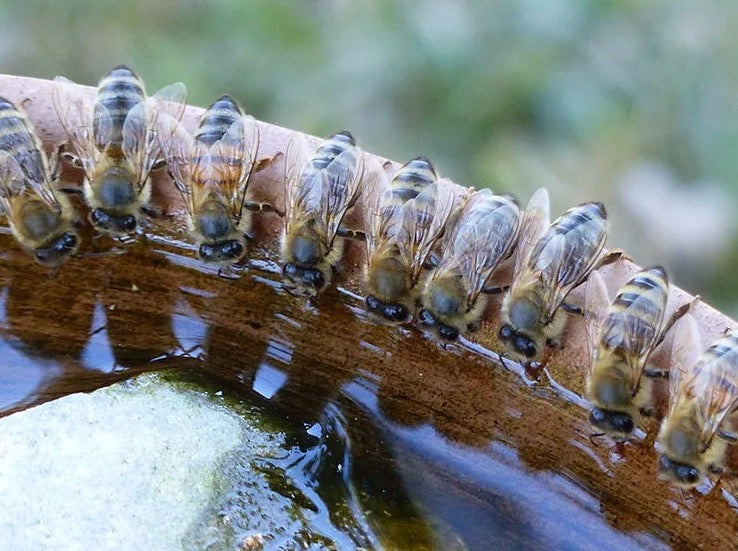A lot of people are surprised when they learn how much water honeybees collect to keep their colony prosperous and running smoothly. On hot dry days, they can require more than a litre just for temperature control! An available water source is very precious. The greater the need the colony has for water, the more of its foraging force tasked with seeking it out, slowing down honey production.
Why do bees need water?
Cooling - In the heat of summer it is used for evaporative cooling. Similar to human-designed air conditioners, the bees spread a thin film of water atop sealed brood (baby bee cells) or on the rims of cells containing larvae and eggs. The workers inside the hive then fan vigorously, setting up air flow which evaporates the water and cools the interior of the hive.
Humidity - Worker bees use water to control the humidity of the colony, not just the temperature.
Utilize Stored Food - Bees need water to dilute stored honey that has naturally crystallized and they need water to dissolve the sugar. Without water, they can't access these food sources.
Larvae Food - Another type of bee in the hive is the nurse bee, who feeds the developing larvae. They consume large amounts of pollen, nectar, and water so that their hypopharyngeal glands can produce the jelly that is used to feed the larvae. A larvae diet can consist of 80 percent water during the first day of growth and about 55 percent on the sixth day. [1]
Digestion - They need it to digest and metabolize their food, as do most organisms.
In most cases, a bee will collect the same thing all day, one trip after another. So once a water-carrying bee transfers her load of water to a house bee, she goes back to the same source and fills her crop again. However, sometimes a forager can’t find a house bee willing to accept her load of water. If that happens, she knows the colony now has all the water it needs, so she begins to forage for something else instead.
Why give them water?
1) Bees are efficient. The closer the water source to the colony, the less flying time per load of water. This will satisfy the needs of the colony more quickly.
2) Bees love pool water! Why? We don’t know! It’s a big issue with pool owners and providing a close water source will keep the relationship with your neighbours on good terms. Same goes for pet water bowls, water troughs for horses and cattle, and kiddie pools!
3) Agricultural Contamination – Often, water runoff in ditches, culverts, or other agriculturally related waterways contains insecticides, pesticides or fungicides which can disrupt brain function, bee learning and the ability to forage for food and so may limit colony growth. Provide a healthy alternative!
Water that smells like wet earth, moss, aquatic plants, worms, decomposition, or even chlorine, has a better chance of attracting a bee than sparkling water straight from the tap. The theory is that stagnant water sources have the advantage of containing a wider range of nutrients although a bee gets most of her nutrients from nectar and pollen, some water sources are rich in vitamins and micronutrients that can improve the honey bee diet.
Normally, a colony forages within a couple kilometres from home. However, when resources are in short supply, a bee may travel 7 to 10 kilometres to get what she needs. Of course, this is inefficient and burns up time and those needed resources in the process. However, the bee system of communicating the location of resources — the dance language — works best for things that are not too close to the hive. For things just a few feet away, a bee can say the source is close, but she has trouble explaining exactly where it is. If the thing is a bit further away, she can give a direction. So for best results, have the bee waterer a short flight from home, perhaps 10 to 40 meters, not right under the hive. Foragers will mark unscented sources of water with their Nasonov pheromone so others can locate the source too.
When first establishing a water source, it can help to spike it with an attractant. A teaspoon of chlorine, salt, lemon oil or lemon grass are all scents they seem to enjoy. Some beekeepers add a handful of ground oyster shells to a pan of water, which gives the water a faintly salty ocean smell the bees find attractive.
When luring the bees, you can stop adding the attractant as soon as the bees become accustomed to the source. After a few days, they will “forget” what was there and simply think of it as water. The most important thing is to establish a pattern early in the season before they develop bad habits.
Key Tips For Designing a Watering Feature For Bees
Shallow and Wide - Bees don't need a deep bucket, just a small amount where they can't drown.
Corks, Rocks, or Twigs - Always place floating wine corks, rocks, or glass pebbles so the bees have a place to get near but not drown in the water.
Fresh Water - It is important the water is refreshed every day or every other day, so under a leaky outdoor faucet is a good spot to place a watering feature.
Best Honey Bee Watering Ideas
Frisbee With Rocks - Put a frisbee full of clean rocks (find them in your yard) underneath a faucet outside, turn the faucet on so it drips once per minute. Over the day it will fill up and provide fresh water for the bees.
Glass Pebbles - Most craft or dollar stores have those bags of glass pebbles you can buy. Buy 1-2 bags of these pebbles and put them in a large (6 or more inches) but shallow container. Fill this with fresh water daily and place it near your garden or outside in a natural area of your yard. Bonus if you put some water loving plants like horsetail, cattail, water loving ferns, etc
Birdbath - Take over the bird bath and decorate with twigs, rocks, pebbles, and wine corks. Add some green ferns or plants to add a bit of colour.
Sources
[1] - http://honeybee.drawwing.org/book/hypopharyngeal-glands
A special thank you to Rusty Berlew, and Ei & Chris from Seedles!

